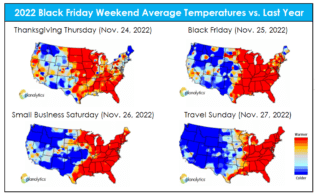Black Friday Weekend Recap From Planalytics
Mother Nature served up a cornucopia of weather supporting traffic into Shopping Destinations over the Holiday Weekend
Regional Trends featured cold conditions in the West, milder in the East.
The Thanksgiving and Black Friday weekend (November 24 – November 27) featured a variety of changeable conditions. Bitter cold in the East from earlier in the week turned milder over the Thanksgiving and Black Friday weekend. The weekend as a whole was the mildest holiday weekend since 2017, although there were notable regional differences. The strongest warmth over the weekend was focused from the Gulf Coast to the Southeast. The coldest year-over-year conditions stretched from the Rockies to the West Coast.
The entire week was the coldest final week of November since 2018. The coldest year-over-year conditions lifted demand for seasonal categories and also supported traffic into stores and shopping centers. Need-based categories performed well as consumers looked to purchase items such as firelogs, hot drinks, and seasonal apparel including sweaters, gloves, and jackets.
According to Sensormatic, in-store foot traffic on Black Friday was up 2.9% compared to 2021 while visits to stores on Thanksgiving Day increased 19.7%. According to Adobe, online sales on Black Friday were the most on record, topping $9 billion, a 2.3% increase over last year, when many businesses were experiencing supply chain issues and inventory challenges. Heading into this holiday season, many retailers reported strong inventory positions and began discounting and promotional activities much earlier.
Rainfall was the most since 2019, although most major markets had no traffic limiting weather. Heaviest rain was in the Southeast and stretched into the Mid-Atlantic region over the weekend. The rain likely supported increased traffic into shopping malls and indoor destinations, while limiting outdoor activities such as putting up lights and decorations. Snowfall was the least since 2020 with minimal amounts that were focused in smaller markets.
Coldest temperatures compared to last year feasted across the West as the Pacific and Mountain regions had their coldest holiday weekend since 2020. Los Angeles, San Francisco, Seattle, Denver, Salt Lake City, Phoenix and Portland, OR were some of the markets in these regions which trended colder than last year. The Great Lakes had its warmest holiday weekend since 2015 and Chicago was warmest since 2011. The South Atlantic, Mid-Atlantic, and New England regions were all warmer to last year with the warmest conditions in the Southeast. Miami, Orlando, Tampa, and Jacksonville had its warmest holiday weekend in over 20 years. In the Mid-Atlantic and Northeast, New York City, Boston, Philadelphia, and Baltimore all trended warmer than LY.
Rainfall was the most since 2019 and was focused in the Southeast and Mid-Atlantic regions. Total amounts for most major markets were not extreme and supported foot traffic into malls and shopping destinations. Snowfall for the weekend was well below normal. Black Friday was ideal for traffic as no measurable snowfall was recorded in the largest markets, the first time this has occurred since 1986.
Looking ahead, Cyber Monday (November 28) will lead into high volume shopping days in December. For reference, December 2021 was the warmest December in 127 years of recorded history. Colder weather in December on a year-over-year basis will have a significant influence on shopping patterns as well as the items consumer place into their baskets. The National Retail Federation (NRF) expects total holiday sales to grow between 6% and 8% compared to 2021.
For more information or to learn how weather can impact your business, Contact Us.





